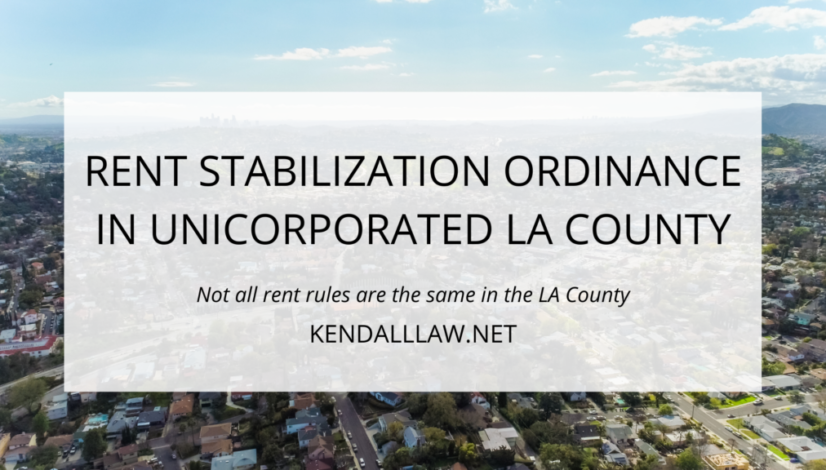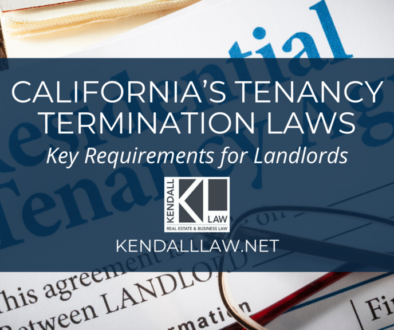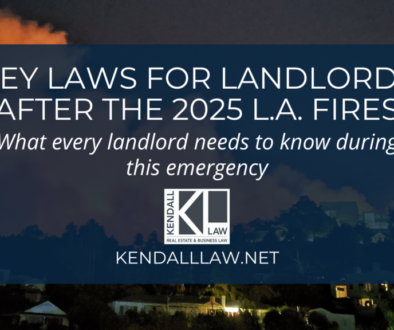Rent Stabilization Rules Vary Within Unincorporated Los Angeles County
Not all rent stabilization rules are the same. Multiunit Properties located the City of Los Angeles are governed by the city’s Rent Stabilization Ordinance (RSO). Multiunit Properties located in unincorporated Los Angeles County have their own rent stabilization rules. There are also separate rules that apply to Santa Monica, West Hollywood, and other cities. But this article is about the new ordinance that deals with properties in unincorporated cities within Los Angeles County.
Unincorporated Rent Stabilization Ordinance
There are approximately 76 unincorporated communities within LA County’s 4,058 square miles. The Unincorporated Rent Stabilization Ordinance (RSO) went into effect on April 1, 2020.
There are two categories of protections under the County’s RSO: (1) Fully covered units, which have rent restrictions and “Just Cause” eviction protections; and (2) Partially covered, or “Just Cause” only units, which protects tenants from evictions without “Just Cause” and applies to most rental units in unincorporated LA County.
Fully-Covered Units under the RSO must:
- Be located in unincorporated Los Angeles County; and
- Be a residential dwelling on a property with two or more rental units, such as apartment complexes and duplexes; and
- Have an initial Certificate of Occupancy or equivalent issued on or before February 1, 1995.
Landlords are required to register all rental units annually, including changes in tenancy, rental rate, and amenities by September 30 of each calendar year.
50% of the registration fee may be passed through to tenants if the landlord timely and accurately submits an annual rental registration to the Department of Consumer and Business Affairs. Registration fee payments are made in 12 equal monthly payments and appear as a separate line item showing the amount of the pass-through costs to tenants provided by the landlord to the Department.
Rent Increases under the RSO
For the landlord to increase rent under the RSO, they must provide at least 30-day notice of rent increases to tenants, the units must be registered with the Department, and not delinquent in registration payments. Rent increases are limited to reflect the average annual change in Consumer Price Index (CPI) and may not exceed 8% in any 12-month period. It should be noted that a landlord may increase rent on Luxury Units registered prior to December 31, 2023, by an additional 2% above the allowable increase but cannot exceed 10% annually.
Collecting Pass-Through Costs
A landlord may collect pass-through costs from existing tenants in covered rental units, by filing an application with the Department. If approved, landlords must give written notice to tenants of collecting said pass-through costs.
Termination of Tenancy
In order to terminate tenancy, landlords must demonstrate For-Cause or No-Fault Termination as defined by the code:
- Landlord must serve a written notice to the tenant that the landlord will terminate because of at least one For-Cause or No-Fault reason.
- Landlord has not accepted and will not accept rent in return for the continued use of the dwelling unit.
- Landlord qualifies termination of tenancy as For-Cause or No-Fault.
- Landlord has submitted to the Department (via certified mail, return receipt requested) a true and accurate copy of the landlord’s written notice of termination, and proof of such service, signed under penalty of perjury on the tenant, within 5 days after service of the notice of termination on the tenant.
If the landlord cannot show termination of tenancy For-Cause or No-Fault, the landlord must renew the rental agreement and permit continued occupancy.
What is For-Cause Termination of Tenancy?
The following circumstances are considered a For-Cause termination of tenancy:
- Failure to pay rent.
- Violation of material terms of rental agreement – after written notice to stop and violation does not cease within 10 days after receiving the notice.*
- Nuisance or Illegal Purpose – including any crime or act of violence committed by a tenant which involves the use of a gun or deadly weapon, or inflicts serious bodily injury and for which a police report has been filed; tenant has created or is maintaining a dangerous and unsanitary condition and that condition has not been promptly abated or repaired after written notice to cure; acts constituting domestic violence, sexual assault or stalking against tenant to a member of tenant’s household.
- Failure to sign substantially similar lease – written demand must be made within 90 days prior to the final day of tenancy of the prior agreement.
- Failure to vacate as required by approved relocation application.
- Households exceeding income limits in government regulated units.
*Note: Additional occupants is not considered a material violation as long as the additional occupants in the unit do not exceed the maximum number of occupants allowed by law.
What is a No-Fault Termination of Tenancy?
The following circumstances are considered a No-Fault termination of tenancy:
- Landlord or landlord’s family member is moving into a unit – a 60-Day Notice period is required and the landlord may only terminate tenancy if the landlord or landlord’s family member who will reside in the unit is similarly suited as the tenant being displaced (i.e., if the tenant is 62 or older, the person moving in must be 62 or older).
- Withdrawal of the unit from the rental market – must comply with all provisions of the Ellis Act.
- Government Agency or Court Order to terminate tenancy.
- Tenant’s right of first return – A tenant may return to the covered unit if the landlord returns the unit to the residential rental market within 5 years.
- Landlords must provide relocation assistance if it is a no-fault termination. LA County will determine the standard relocation assistance parameters and the payments by the landlord for relocation will be made into an escrow account.
Tenant Buyout Agreements
Prior to making a tenant buyout offer, landlords must give tenants notice on a form approved by the Department. If the (tenant?) does not meet the requirements, the buyout offer can be rescinded by the landlord within 45 days. ? The buyout agreement has to be filed with the Department.
Temporary Relocation Assistance under the SRO
A landlord must pay a tenant’s relocation for those tenants displaced due to repairs that cannot be completed while in the unit. If this period is 30 days or less, the landlord must pay a per-diem payment. If it is 31 days or more, the landlord must pay a per-diem or provide comparable temporary accommodations. The per-diem is based on the Federal General Services Administration for lodging in Los Angeles County. Plus, a landlord must, at its expense, hire a relocation specialist with experience in providing relocation services to tenants in the county.
Complexity Made Simple
Whether you have property within Los Angeles County or in an unincorporated area of the County, understanding the law and what’s allowable or not permissible is critical to protecting your property, well-being of your tenants and your real estate investment. Please feel free to reach out to us at Kendall Law to confirm your best course of action before you take action and save yourself legal headaches in the long-run.
Contact us at (310) 619-4941 so we can help you take the right steps and hopefully avoid costly litigation. Kendall Law is here to help.
Author: Eileen Kendall





